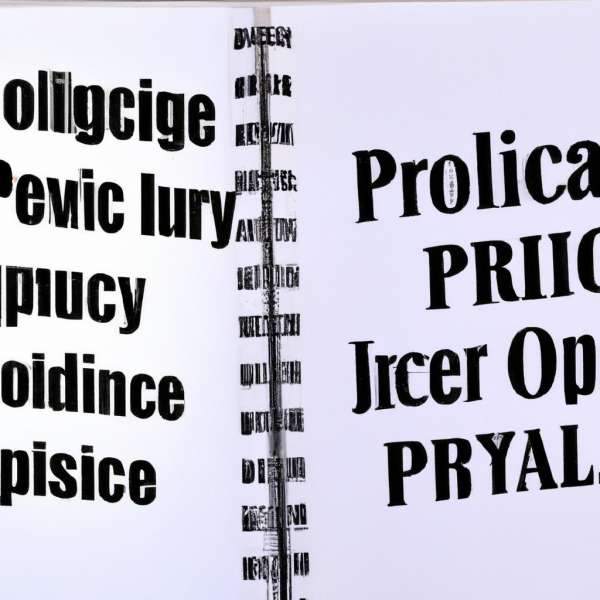In the intricate tapestry of personal injury cases, where narratives of accidents and their aftermath unfold, police reports emerge as critical threads that weave together the often fragmented accounts of events. These documents, typically viewed as mere formalities, carry significant weight in the realm of law, serving as official records that encapsulate the facts surrounding an incident. They not only provide vital information regarding the circumstances of an injury but also offer insights into liability, eyewitness accounts, and the responses of first responders. As we delve into the essential role of police reports within personal injury litigation, we will uncover their influence on legal strategies, their impact on settlements, and their undeniable significance in the quest for justice. Through this exploration, we aim to illuminate the often-overlooked importance of these reports, highlighting how a simple piece of paper can sway the course of a case, shaping the experiences of those involved.
The Significance of Police Reports in Establishing Liability for Personal Injuries
In personal injury cases, police reports serve as a pivotal source of information that can greatly influence the determination of liability. When an incident occurs, law enforcement officers collect firsthand accounts, evidence, and observations, compiling them into a formal report. This documentation is often the first and most credible record of the events surrounding the incident, which can prove vital in legal proceedings.
**Key components typically included in a police report:**
- Incident Details: A comprehensive outline of what transpired, including the time, location, and nature of the events.
- Witness Statements: Accounts from individuals who witnessed the incident, providing varying perspectives that can clarify the circumstances.
- Damage Assessments: Observations about property damage, injuries sustained, and any immediate actions taken.
- Officer’s Observations: Insight from law enforcement regarding conditions such as weather, visibility, and whether any laws were violated.
The weight of a police report in court cannot be understated. It often serves as a baseline for establishing liability, helping judges and juries differentiate between negligence and other factors that may contribute to the incident. Moreover, the credibility of law enforcement endorses the information presented, giving it a greater influence than testimonies alone. In many cases, insurance companies also place significant reliance on these reports when evaluating claims, which can expedite the claims process.
Given its importance, it’s crucial for victims of personal injuries to obtain a copy of the police report. Below is a sample of how police report data can be summarized for clarity:
| Incident Type | Date | Location | Involved Parties |
|---|---|---|---|
| Car Accident | 03/15/2023 | Main St. & 2nd Ave. | John Doe, Jane Smith |
| Slip and Fall | 04/20/2023 | Local Grocery Store | Alice Johnson |
police reports encapsulate essential elements that can determine accountability in personal injury cases. Their reliability, detailed accounts, and unbiased perspective play a crucial role in untangling the complexities of liability. Understanding the significance of these documents can empower victims in their pursuit of justice.

Understanding the Components of Police Reports and Their Impact on Legal Outcomes
Police reports serve as essential documents in personal injury cases, detailing the events leading up to an incident, the parties involved, and the actions taken by law enforcement. Their structured nature provides a factual framework that can influence the legal outcomes of an injury claim. The reports typically include several key components:
- Incident Summary: A concise description of what occurred during the incident, including time, date, and location.
- Witness Statements: Accounts from individuals who observed the event, offering diverse perspectives that may bolster or challenge claims.
- Officer Observations: Details noted by the responding officer, which can reflect the scene’s condition, potential negligence, or violations of the law.
- Photographs and Diagrams: Visual evidence that helps recreate the event and provide context to the written account.
Understanding these components is crucial, as they can significantly impact the direction of a case. For example, inaccuracies or discrepancies in a police report may lead to legal challenges, while strong witness testimonies can enhance a case’s credibility. Furthermore, the report’s language and tone can influence how the facts are perceived by judges and juries. Even seemingly minor details can sway opinions, making the role of police reports pivotal in navigating personal injury claims.
To illustrate the potential consequences of various police report elements, consider the following table that highlights how different components can affect legal outcomes:
| Report Component | Potential Impact on Legal Outcomes |
|---|---|
| Incident Summary | A clear, detailed summary can establish liability. |
| Witness Statements | Corroborative witness accounts can strengthen a case. |
| Officer Observations | Professional observations may lend credibility to one party’s claims. |
| Photographs and Diagrams | Visuals can clarify complex situations and concepts. |
Ultimately, the accuracy and clarity of a police report can shape the landscape of a personal injury case, making it imperative for all parties involved to comprehend how these documents function within the legal framework.

Strategies for Effectively Utilizing Police Reports in Personal Injury Litigation
To maximize the impact of police reports in personal injury litigation, it is essential to use them strategically throughout the legal process. Understanding the nuances of the report, including statements from witnesses and the responding officer’s observations, can provide invaluable context related to the incident. Consider these effective strategies:
- Thoroughly Analyze the Report: Take the time to dissect the police report. Look for critical details such as the time of the incident, precise location, and any cited violations. Understanding these factors can bolster your case by establishing liability.
- Corroborate Witness Accounts: Use the eyewitness testimonies included in the report as a foundation for further investigation. Reach out to these witnesses for additional statements, which can enhance the credibility of your claims.
- Utilize Officer Observations: The attending officer’s observations often include details that might not be captured elsewhere. Their professional assessment can serve as persuasive evidence regarding the scene of the incident and the parties involved.
Moreover, it can be helpful to create a visual representation of the critical data extracted from the police report. Below is a simple table that illustrates key elements that can assist in organizing your findings effectively:
| Element | Importance |
|---|---|
| Date & Time | Establishes timeline of events |
| Location | Determines jurisdiction and relevance |
| Involved Parties | Identifies potential defendants |
| Witness Statements | Supports or opposes claims made |
| Traffic Violations | Highlights legal liability |
Incorporating police reports not only strengthens a personal injury case but also paves the way for clearer communication with the opposing party. By leveraging the contents of the report thoughtfully, you can enhance your negotiation position or prepare a compelling argument in court.

Best Practices for Obtaining and Interpreting Police Reports in Your Case
Obtaining police reports is a critical step in building a solid foundation for your personal injury case. To effectively gather these documents, it’s important to follow a few best practices:
- Request Promptly: Timing is essential. Always request your police report as soon as possible after the incident. This not only helps ensure accuracy but also keeps the information fresh in the minds of those involved.
- Know What to Expect: Familiarize yourself with the types of reports available—such as accident reports, arrest reports, and incident reports. Understand the specific details you need for your case to tailor your requests appropriately.
- Follow the Right Channels: Each police department has their own process for requesting reports. Visit the department’s website or contact them directly for the correct procedure, including any associated fees.
Once you obtain the report, interpretation is key. Being able to extract relevant information while understanding its context can significantly impact your case. Here are some guidelines for interpreting police reports effectively:
- Analyze Details: Pay close attention to details such as the **date, time**, and **location** of the incident, as well as witness statements and the officer’s observations. These elements can often serve as critical components in establishing liability.
- Look for Inconsistencies: If the police report contains statements that contradict your understanding of events, it’s important to highlight these discrepancies in your case. This could strengthen your position or prompt further investigation.
- Consult Legal Experts: Engaging with attorneys experienced in personal injury law will help you interpret complex legal language used in police reports. They can provide insights into how certain details might influence your case outcome.
To further illustrate the role of police reports, consider the following table of key elements often found in these documents:
| Element | Importance |
|---|---|
| Accident Location | Identifies where the incident occurred. |
| Involved Parties | Details who was present and their roles in the incident. |
| Witness Statements | Offers third-party perspectives which can be pivotal. |
| Officer’s Narrative | Summarizes the officer’s interpretation of the event. |
Utilizing these best practices for obtaining and interpreting police reports can empower you in advocating for your personal injury case.
Concluding Remarks
the significance of police reports in personal injury cases cannot be overstated. They serve as crucial evidence, providing a factual account of incidents that can influence the course of legal proceedings. While they are not infallible, their objective nature often lends them weight in court, helping to shape narratives and support claims. Understanding their contents, implications, and limitations equips both victims and legal professionals with the tools needed to navigate the often complex landscape of personal injury law. As we move forward, it is essential to appreciate the delicate interplay between police documentation and the pursuit of justice, ensuring that every voice is heard and every story is told. Ultimately, police reports are not merely procedural documents; they are pivotal pieces in the intricate puzzle of accountability and resolution in the aftermath of accidents.


